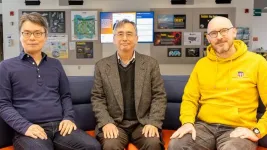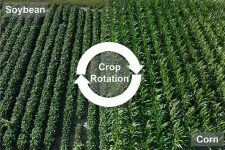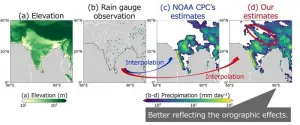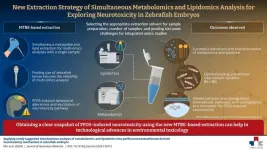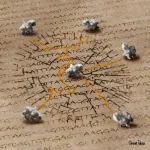(Press-News.org) Three scientists were awarded the 2024 Kaul Foundation Prize for Excellence in Plasma Physics Research and Technology Development based on their decades of groundbreaking research about how plasma behaves in fusion reactors.
Choongseok (CS) Chang, Seung-Hoe Ku and Robert Hager of the U.S. Department of Energy’s (DOE) Princeton Plasma Physics Laboratory (PPPL) were recognized “for experimentally validated simulations of turbulence-broadened divertor heat flux widths using the X-Point Included Gyrokinetic Code (XGC),” following decades of research developing comprehensive simulations to model the fusion plasma edge.
Recently, the scientists – in collaboration with researchers from the Massachusetts Institute of Technology (MIT) and other collaborators working on the DIII-D fusion device at General Atomics – determined that these simulations closely matched experiments in the DIII-D. The research showed that the turbulence doubles the exhaust layer width in conditions similar to what would be found in a commercial-scale reactor such as ITER. This is an important experimental validation that XGC can describe the relevant underlying physics, helping support XGC predictions that ITER could have a much broader exhaust footprint than what has been predicted by present tokamak data.
This simulation code has been critical for a great deal of research that has advanced fusion science. The code simulates the whole volume of a tokamak plasma, especially the edge region of the magnetically confined plasma that includes the area where magnetic field lines cross, which is known as the X-point. This area is particularly important to study because of its reduced confining magnetic field strength, which can allow plasma particles to escape confinement. XGC is widely considered one of the best such codes available and is used by researchers worldwide on some of the planet’s most powerful computers.
“This work has brought great honor to the Lab,” said PPPL Director Steve Cowley when he presented the award at PPPL’s annual State of the Lab address. “This high-performance computing exascale project code, developed at our Lab, is also being honored by the U.S. Secretary of Energy with the prestigious Secretary’s Honor Award as part of the broader exascale computing initiative.”
Using very powerful hardware, exascale computers can perform one quintillion (or a billion billion) calculations per second, which makes them faster than the most powerful supercomputers currently used.
Each recipient of the annual Kaul Foundation Prize receives $7,500 in recognition of their scientific achievement. The prize was established with funds from the late PPPL Director Ronald C. Davidson’s 1993 Award for Excellence in Science, Education and Physics. It honors outstanding contributions to research in plasma physics.
Notably, the 2024 winners used XGC to determine critical details about how ions and electrons escape the core plasma during fusion when the plasma is confined by magnetic fields inside a tokamak. Their highly sophisticated simulation is for ITER, the multinational fusion facility under construction in France. The simulation suggests that a key region of the ITER wall should not get as hot as once feared based on the experimental data from present-day tokamaks.
“We would like to thank the national and international XGC team members. For the divertor heat load research, credit goes to the ITER Organization collaborators led by Alberto Loarte and Richard Pitts; PPPL, DIII-D, Alcator C-Mod, National Spherical Torus Experiment and Lawrence Livermore National Laboratory participants in the 2016 DOE Office of Science national theory milestone activities that led to the discovery of the ion leakage and turbulent electron loss physics that are responsible for plasma exhaust. We also thank the joint PPPL/DIII-D research team led by Alessandro Bortolon for the XGC application on DIII-D edge plasma and Darin Ernst of MIT for collaborating with us to simulate his experiments in ITER-like conditions, which turned out to be ideal for validating the XGC simulations,” said Chang.
“We hope to see more experimental validations on other tokamaks. We also would like to thank the tremendous support from the DOE program managers, DOE computer centers and PPPL management, which made the research possible.”
Choongseok (CS) Chang
After graduating with a doctoral degree in physics from the University of Texas at Austin in 1979, Chang was a senior scientist at General Atomics in San Diego before holding a tenure position at the Korea Advanced Institute of Science & Technology (KAIST). He later moved back to the U.S. and worked at the Courant Institute of Mathematical Sciences at New York University (NYU) before ultimately landing at PPPL in 2011.
Chang’s long career in plasma physics has focused on solving key theoretical challenges to make fusion a reliable source of electricity. Chang has spent decades leading multidisciplinary teams of physicists, applied mathematicians and computer scientists — including those who use artificial intelligence — to lead the development of XGC and simulate the extremely complex environment inside fusion reactors.
“Plasma is not a single physics phenomenon. Several physics interact together. But that was a very difficult theory to develop,” said Chang. Additionally, the problem was multiscale, meaning it needed to be studied at multiple levels of detail.
“Fortunately, I had a hunch in the late 1990s that computers would become more and more powerful so we could solve these problems,” Chang said. He recruited “a few brilliant students” to work on this important task. Among them, Ku was the main workforce. At the time, creating models that considered multiple physics simultaneously was considered nearly impossible. But Chang and the talented team – especially Ku – persisted. Ultimately, the work developing the necessary computer codes that could realize his multiphysics vision would receive substantial funding from the DOE and recognition from major U.S. computer centers. The success of this work eventually led Chang to resign from his positions in Korea and at NYU to fully dedicate himself to the XGC project and scientific discovery at PPPL. More young and talented physicists joined the development team and raised the code to a higher capability level. Among them, Hager became another distinguished developer and physics researcher.
One of the most rewarding aspects for Chang is seeing his younger group members become successful computational physicists in their own right. His advice to young physicists is to think big. “Don’t be afraid to attack challenging and ambitious scientific problems,” he said.
Seung-Hoe Ku
Ku has been a research physicist at the Lab since 2011, following Chang’s move. He received his doctoral degree in physics from KAIST in 2004.
Ku has been deeply involved in the research and development of the XGC code for decades, starting from when he was a graduate student at KAIST. Ku was effectively the sole person writing an initial version of what would one day become the backbone of XGC while he was still a graduate student.
“This has been a lifelong pursuit,” Ku said. He has seen the code through many iterations, moving it from a two-dimensional code into three dimensions and adding code to include turbulence, for example.
“When I extended it to 3D, a few people came on board to help with code performance,” Ku said. Now, many people around the world are working on XGC, with Ku and Hager focusing on managing the core of the code.
Ku has been interested in physics since middle school. In high school, he also developed an interest in coding. With some friends, Ku wrote what he describes as a precursor to the popular video game Angry Birds. “You throw the ball, and then it calculates the trajectory,” Ku said. “At the time, it was just for fun. But I think that’s my first physics simulation of particles.”
Ku would like to thank his wife, Haehyun Nam, for her patience.
Robert Hager
Hager received a doctoral degree in plasma physics jointly from the Technical University of Munich and the Max Planck Institute for Plasma Physics in 2011. The following year, he came to PPPL as a postdoctoral researcher. Hager has been working with Chang and Ku on XGC ever since. He became a core developer and is now a research physicist at the Lab.
“Winning the Kaul Prize is confirmation that what we’ve been doing all those years actually makes sense and produces good results,” Hager said. People sometimes question why he would work so hard on a code that is so complex it can only run using the world’s most powerful computers. “Now, finally, I think more people are seeing our results and realizing we can reproduce what people are seeing in experiments and get better insights,” Hager said.
In addition to being one of the main authors and managers of XGC, Hager is also responsible for training and supporting XGC users worldwide.
Hager says the field was definitely the right choice for him. “As a scientist, you sometimes have long stretches where nothing seems to work. But when you find a solution, you understand something new, and that is so rewarding. I also like the technical aspect, tinkering with computer tools.”
Like many in the field, Hager was initially drawn to plasma physics because of the environmental aspect of clean energy from fusion. However, there were also personal factors: His position at Max Planck brought him closer to his girlfriend, who he would later marry. “I would like to thank my wife, Sofia, my Ph.D. supervisor Klaus Hallatschek and everyone who helped make XGC what it is today.”
END
State-of-the-art fusion simulation leads three scientists to the 2024 Kaul Foundation Prize
Prize Their simulation is one of many critical insights that have come from decades of work on a computer code known as XGC
2025-01-15
ELSE PRESS RELEASES FROM THIS DATE:
Davos Alzheimer's Collaborative launches innovative brain health navigator program for intuitive coordination between patients and providers
2025-01-15
The Davos Alzheimer’s Collaborative (DAC), a pioneering worldwide initiative seeking to cure Alzheimer’s disease and improve brain health, today announced the launch of its Brain Health Navigator program. The initiative led by the DAC Healthcare System Preparedness (DAC-SP) team will provide resources for patients and providers at six sites across the U.S.
Despite Alzheimer’s status as a growing worldwide epidemic, pathways for accurate diagnosis and evidence based interventions including new therapies are either underdeveloped or non-existent. ...
Media registration now open: ATS 2025 in San Francisco
2025-01-15
New York, NY – Jan. 15, 2025 –We are excited to welcome you to San Francisco for the ATS 2025 International Conference! Journalists will have access to leaders, as well as emerging scientists and clinicians, who are at the forefront of medical breakthroughs and clinical innovation in pulmonary, critical care and sleep medicine.
Join us beginning Sunday, May 18* through Wednesday, May 21. Register now and check out our Program at a Glance.
As always, you are welcome to contact the ATS communications and marketing director about scientific sessions and expert interviews whether you are joining us in person or from your (home) office. Registered ...
New study shows that corn-soybean crop rotation benefits are extremely sensitive to climate
2025-01-15
MINNEAPOLIS / ST. PAUL (01/15/2024) — A study by researchers at the University of Minnesota Twin Cities offers new insights into how alternating corn and soybean crops can help increase crop yield in a changing climate.
The research is published in the peer-reviewed scientific journal Global Change Biology.
Rising temperatures and weather extremes are threatening global food security, making it crucial to understand how sustainable practices like crop rotation can help improve agricultural yields and resilience.
The study found that the benefits to corn-soybean rotation, compared to continuous corn year after year, are extremely sensitive to ...
From drops to data: Advancing global precipitation estimates with the LETKF algorithm
2025-01-15
With the increase in climate change, global precipitation estimates have become a necessity for predicting water-related disasters like floods and droughts, as well as for managing water resources. The most accurate data that can be used for these predictions are ground rain gauge observations, but it is often challenging due to limited locations and sparse rain gauge data. To solve this problem, Assistant Professor Yuka Muto from the Center for Environmental Remote Sensing, Japan, and Professor Shunji Kotsuki of the Institute for Advanced Academic Research, Center for Environmental Remote Sensing, ...
SeoulTech researchers propose a novel method to shed light on PFOS-induced neurotoxicity
2025-01-15
The term “omics” refers to the study of entirety of molecular mechanisms that happen inside an organism. With the advent of omics technologies like transcriptomics, proteomics, metabolomics, and lipidomics, our understanding of molecular pathways of toxic environmental pollutants has deepened. But most environmental toxicology studies are still dependent on a single-omics analyses, leading to gaps in our understanding of integrated toxicity pathways of pollutants. Researchers from all over the world have ...
Large-scale TMIST breast cancer screening trial achieves enrollment goal, paving the way for data that provides a precision approach to screeninge
2025-01-15
The Tomosynthesis Mammographic Imaging Screening Trial (TMIST) has reached its enrollment goal of 108,508 women, as announced today by the ECOG-ACRIN Cancer Research Group (ECOG-ACRIN). The study, funded by the National Cancer Institute (NCI), one of the National Institutes of Health, will now proceed with the completion of regularly scheduled mammograms and follow-up on all participants through 2027. Key in this follow-up is the collection of biospecimens and data that will help researchers learn how to personalize breast cancer screening for women.
Participants in TMIST were randomly ...
Study published in NEJM Catalyst finds patients cared for by MedStar Health’s Safe Babies Safe Moms program have better outcomes in pregnancy, delivery, and postpartum
2025-01-15
WASHINGTON - Women who were cared for by the MedStar Health D.C. Safe Babies Safe Moms program (SBSM) have better outcomes in pregnancy, delivery, and postpartum, according to a study published today in NEJM Catalyst Innovations in Care Delivery. Additionally, the study showed that Black patients cared for by SBSM were also less likely to have low or very low birthweight babies or preterm birth than Black or White patients who received prenatal care elsewhere.
Compared to patients who received prenatal care elsewhere, patients cared for under Safe ...
Octopus arms have segmented nervous systems to power extraordinary movements
2025-01-15
Octopus arms move with incredible dexterity, bending, twisting, and curling with nearly infinite degrees of freedom. New research from the University of Chicago revealed that the nervous system circuitry that controls arm movement in octopuses is segmented, giving these extraordinary creatures precise control across all eight arms and hundreds of suckers to explore their environment, grasp objects, and capture prey.
“If you're going to have a nervous system that's controlling such dynamic movement, that's a good way to set it up,” said Clifton Ragsdale, PhD, Professor of Neurobiology at UChicago and senior author ...
Protein shapes can help untangle life’s ancient history
2025-01-15
The three-dimensional shape of a protein can be used to resolve deep, ancient evolutionary relationships in the tree of life, according to a study in Nature Communications.
It is the first time researchers use data from protein shapes and combine it with data from genomic sequences to improve the reliability of evolutionary trees, a critical resource used by the scientific community for understanding the history of life, monitor the spread of pathogens or create new treatments for disease.
Crucially, the approach works even with the ...
Memory systems in the brain drive food cravings that could influence body weight
2025-01-15
PHILADELPHIA, PA (January 15, 2025) - Can memory influence what and how much we eat? A groundbreaking Monell Chemical Senses Center study, which links food memory to overeating, answered that question with a resounding “Yes.” Led by Monell Associate Member Guillaume de Lartigue, PhD, the research team identified, for the first time, the brain’s food-specific memory system and its direct role in overeating and diet-induced obesity.
Published in Nature Metabolism, they describe a specific population of neurons in the mouse brain that encode memories for sugar and fat, profoundly impacting food intake and body ...
LAST 30 PRESS RELEASES:
Heart-brain connection: international study reveals the role of the vagus nerve in keeping the heart young
Researchers identify Rb1 as a predictive biomarker for a new therapeutic strategy in some breast cancers
Survey reveals ethical gaps slowing AI adoption in pediatric surgery
Stimulant ADHD medications work differently than thought
AI overestimates how smart people are, according to HSE economists
HSE researchers create genome-wide map of quadruplexes
Scientists boost cell "powerhouses" to burn more calories
Automatic label checking: The missing step in making reliable medical AI
Low daily alcohol intake linked to 50% heightened mouth cancer risk in India
American Meteorological Society announces Rick Spinrad as 2026 President-Elect
Biomass-based carbon capture spotlighted in newly released global climate webinar recording
Illuminating invisible nano pollutants: advanced bioimaging tracks the full journey of emerging nanoscale contaminants in living systems
How does age affect recovery from spinal cord injury?
Novel AI tool offers prognosis for patients with head and neck cancer
Fathers’ microplastic exposure tied to their children’s metabolic problems
Research validates laboratory model for studying high-grade serous ovarian cancer
SIR 2026 delivers transformative breakthroughs in minimally invasive medicine to improve patient care
Stem Cell Reports most downloaded papers of 2025 highlight the breadth and impact of stem cell research
Oxford-led study estimates NHS spends around 3% of its primary and secondary care budget on the health impacts of heat and cold in England
A researcher’s long quest leads to a smart composite breakthrough
Urban wild bees act as “microbial sensors” of city health.
New study finds where you live affects recovery after a hip fracture
Forecasting the impact of fully automated vehicle adoption on US road traffic injuries
Alcohol-related hospitalizations from 2016 to 2022
Semaglutide and hospitalizations in patients with obesity and established cardiovascular disease
Researchers ‘listen in’ to embryo-mother interactions during implantation using a culture system replicating the womb lining
How changing your diet could help save the world
How to make AI truly scalable and reliable for real-time traffic assignment?
Beyond fragmented markets: A new framework for efficient and stable ride-pooling
Can shape priors make road perception more reliable for autonomous driving?
[Press-News.org] State-of-the-art fusion simulation leads three scientists to the 2024 Kaul Foundation PrizePrize Their simulation is one of many critical insights that have come from decades of work on a computer code known as XGC
